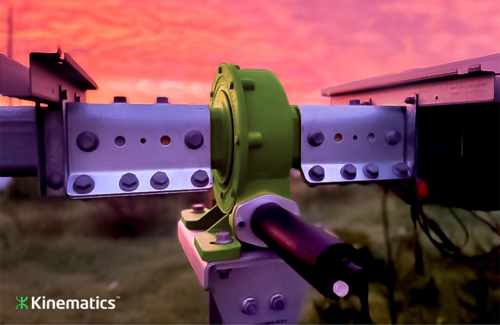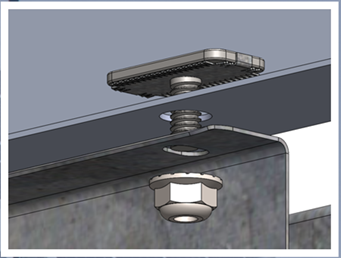 位于美国弗吉尼亚州 Spotsylvania 的 75MW 项目,使用 Nextracker 解决方案。图片:sPower/Nextracker。
位于美国弗吉尼亚州 Spotsylvania 的 75MW 项目,使用 Nextracker 解决方案。图片:sPower/Nextracker。
由于地形或施工容差的变化而导致的行间阴影是大型太阳能发电厂中特别有害的损失来源。为什么?因为不仅可以使用行业标准软件对地形阴影损失进行建模,而且使用先进的系统设计和控制策略可以恢复大部分损失。
不久前,无论是在莫哈韦沙漠还是科罗拉多州的圣路易斯山谷,行业利益相关者都可以将广阔的平坦阳光土地用于太阳能项目开发。由于这些开创性的站点基本上没有复杂的地形,性能模型可以通过假设平坦表面上的标准回溯来表征这些站点。这些基本假设不再适用于该行业。
今天,公用事业规模的太阳能越来越多地出现在地形复杂的地方——这些地方在五年前似乎还不适合开发太阳能。此外,“完全平坦”的网站一直是一个神话而不是现实。在太阳能建筑工地上扫描成排的驱动桥墩,桥墩高度变化明显,即使在相对平坦的场地上相邻的排也是如此。即使在最好的情况下,某些地形差异也是不可避免的,特别是考虑到当今项目站点的规模。
光伏会议上一个常见的主题是,部署资产的表现低于预期,而且没有人真正知道原因。一种合理的解释是,问题不在于部署的资产,而在于我们的期望。根据您的观点,跟踪器地形损失要么是房间里无人谈论的大象,要么是无人采摘的低垂果实。
如果跟踪器地形损失没有准确建模,PVsyst 生产建模模拟以及这些提供的收入模型将倾向于高估光伏电站的性能。始终低估这些影响可能会削弱投资者的回报和信心。此外,只要在项目开发、设计和采购过程中一直低估这些可避免的系统损失,就没有什么紧迫性或动力来追回可避免的系统损失。
虽然地形阴影损失是一个真正的问题,但光伏性能建模社区正视这个问题。作为 2021 年 IEEE 光伏专家会议 (PVSC) 会议的一部分,来自 DNV 的一组性能工程师介绍了正在进行的地形阴影损失研究的结果[1]。作者使用 DNV 的 SolarFarmer 软件对北卡罗来纳州平均西南坡度为 4% 的场地进行建模。作者分析了水平地面上跟踪器之间的产量与可变地形上的产量的差异,发现跟踪器地形损失为 -2%。
Black & Veatch 工程师最近的工作产生了类似的结果[2]。作者在美国东部一个由湿地纵横交错、东西向坡度约为 3% 的地点研究拟建的光伏电站,作者模拟了大约 -2.5% 的地形产量损失。分析地形自适应回溯策略的影响,作者得出结论,可以弥补大部分地形阴影损失。
Nextracker 自己的建模结果验证了与倾斜地形相关的产量损失估计的粗略数量级。在具有高漫射辐照度含量的位置,使用标准回溯法,根据地面覆盖率 (GCR),轻度 3% 的等级会导致每年 1% 至 2.5% 的损失。请注意,我们使用“耐阴”半切电池模块对这些结果进行了建模,如图 1 所示。

然后,我们根据具有代表性的 100 MW 单轴跟踪器安装工厂和特定区域的平均 PPA 率将此分析扩展到多个位置。如图 2 所示,与跟踪器地形阴影损失相关的财务影响远非微不足道。每年,地形阴影损失约为 100,000 至 200,000 美元。这是预期与现实之间的巨大差距,尤其是对于密切跟踪整个车队项目财务状况的资产所有者而言。在项目的整个生命周期内推断,运营 30 年的收入损失现值(折现率约为 5%)很容易超过每 100 兆瓦电厂容量 200 万美元。

这种表现不佳风险的重要性值得对地形阴影损失建模采取更严格的方法。最新版本的事实上的行业标准性能建模软件 PVsyst 7 为东西坡变化提供了基本的跟踪器地形阴影损失建模功能。结合 Nextracker 的地形建模最佳实践指南,工程师可以将真实工厂布局的 AutoCAD 文件导入 PVsyst,覆盖来自 USGS 或现场调查的详细地形,并估计东西坡度变化的影响。这种额外的严格性使所有利益相关者(开发商、EPC、IE、保险公司和投资者)受益,因为它们提高了对大型工厂产量损失关键来源的透明度和信任度。
为了弥补地形和施工公差损失,项目利益相关者可以在现场系统中部署高级跟踪算法,例如 Nextracker 的 TrueCapture 技术。在 Nextracker 的高速、高精度和高粒度跟踪硬件的支持下,TrueCapture 算法使用精确的站点和特定于安装的信息来计算每个独立跟踪器行的优化控制策略。
通过最大限度地减少行级地形阴影损失,Nextracker 能够最大限度地提高系统级产量。Nextracker 还拥有专有的建模解决方案 TrueSim,它不仅可以估算与 TrueCapture 相关的良率收益,还可以提供已实现收益的验证过程。建模和减轻地形阴影损失只是 Nextracker 通过创新技术和数据分析继续优化太阳能发电厂性能的众多方法之一。
随着越来越大的光伏项目频率和分布的增加,太阳能开发的“简单”站点越来越成为过去。具有有意义的地形变化的受限站点正在成为常态。为其 PVSC 纸建模的 4% 平均等级 DNV 在当今市场上并不罕见。如果有的话,这是一个保守的平均值,因为当地的坡度可能高达 15%。好消息是坡度感知回溯减轻了与复杂地形相关的阴影损失。
实现坡度感知回溯的通用方法是根据需要切割和填充场地以实现均匀坡度。如果然后将桥墩驱动到相对于该分级单翼飞机的统一高度,则结果是平面内跟踪器布局。不幸的是,完美的平面内跟踪器布局并不是现实。对数千英亩的土地进行切割和分级不仅不切实际,而且在土壤稳定和栖息地保护方面也可能适得其反。
智能控制的独立行跟踪器非常适合捕获太阳能资产的全部产量并最大限度地提高其经济性能。在现实世界中,大型公用事业规模太阳能站点的地形变化是不可避免的。在现实生活中,跟踪器桥墩的顶部很少会产生完美的平面。在这个不完美的世界的背景下,减轻跟踪器地形损失的最有效方法通常是最细粒度的。
参考文献
[1] 米科夫斯基,M.;哈默,M。纽伯特,A.;梁,M。帕里克,A.;Kharait, R.; 跟踪器地形损失第二部分。IEEE 光伏专家会议,2021 年 6 月。
[2] 坎凯维奇,A.;来自近阴影和复杂地形的光伏电站性能挑战。太阳能建筑商杂志,2021 年 5 月。
作者
Aron Dobos 是 Nextracker 的软件产品管理总监,而 Neelesh Umachandran 是 Nextracker 的性能工程师。
原文:
Tracker terrain loss: The elephant in the room and the low-hanging fruit
Row-to-row shading resulting from variability in terrain or construction tolerance is a particularly pernicious source of loss in large-scale solar power plants. Why? Because it is not only possible to model terrain shade loss using industry-standard software, but also a lion’s share of these losses can be recovered using advanced system design and control strategies.
Not so long ago, industry stakeholders could target vast expanses of flat sunny land for solar project development, whether in the Mojave Desert or the San Luis Valley of Colorado. Since these pioneering sites were largely devoid of complex terrain, performance models could characterise these sites by assuming standard backtracking on a flat surface. These basic assumptions no longer serve the industry well.
Today, utility-scale solar increasingly shows up on sites with complex terrain — places that would have perhaps seemed unsuitable for solar development only five years ago. Moreover, ‘perfectly flat’ sites have always been more of a myth than a reality. Scanning rows of driven piers across a solar construction site, pier heights vary noticeably, even in adjacent rows on relatively flat sites. Even in the best of circumstances, some terrain variance is inevitable, especially given the magnitude of today’s project sites.
A common, if quiet, theme at PV conferences is that fielded assets are underperforming relative to expectations and no one really knows why. One plausible explanation is that the problem lies not with the fielded asset, but rather with our expectations. Depending on your perspective, tracker terrain losses are either the elephant in the room that no one is talking about or the low-hanging fruit that no one is harvesting.
If tracker terrain loss is not accurately modelled, PVsyst production modelling simulations, and the revenue models these inform, will tend to overestimate PV plant performance. Consistently underestimating these impacts could erode investor returns and confidence. Moreover, there is little urgency or incentive to clawback avoidable system losses so long as these are consistently underestimated during project development, design and procurement.
While terrain shade loss is a real problem, the PV performance modelling community has this issue squarely in its sights. As part of the 2021 IEEE PV Specialists Conference (PVSC) proceedings, a group of performance engineers from DNV presented the results of an ongoing terrain shade loss study[1]. The authors used DNV’s SolarFarmer software to model a site in North Carolina with a 4% average southwest slope. Analysing the difference in yield between trackers on horizontal ground relative to the yield on variable terrain, the authors found a tracker terrain loss of -2%.
Recent work by engineers at Black & Veatch yielded similar results[2]. Studying a proposed PV plant in the Eastern U.S. at a site crisscrossed by wetlands with east-west slopes of around 3%, the authors modelled terrain yield loss of approximately -2.5%. Analysing the impact of a terrain-adaptive backtracking strategy, the authors concluded that it was possible to recoup a majority of the terrain shade loss.
Nextracker’s own modelling results validate the rough order of magnitude of yield loss estimates associated with sloped terrain. In a location with high diffuse irradiance content, a mild 3% grade can result in annual losses ranging between 1%–2.5%, depending on ground coverage ratio (GCR), using standard backtracking. Note that we modelled these results, shown in Figure 1, using “shade tolerant” half-cut cell modules.

We then expanded this analysis, based on a representative 100MW single-axis tracker-mounted plant and region-specific average PPA rates, to multiple locations. As shown in Figure 2, the financial impact associated with tracker terrain shade loss is far from insignificant. Annually, the terrain shade loss is on the order of US$100,000 – 200,000. This is a big gap between expectations and reality, especially for asset owners closely tracking fleetwide project financials. Extrapolated over the life of the project, the present value of revenue loss over 30 years of operation, discounted at roughly 5%, is easily over US$2 million per 100 MW of plant capacity.

The significance of this underperformance risk merits a more disciplined approach to terrain shade loss modelling. The most recent version of the de facto industry standard performance modelling software, PVsyst 7, provides basic tracker terrain shade loss modelling capabilities for east-west slope variance. Coupled with Nextracker’s best practice guidelines for terrain modelling, engineers can import AutoCAD files of real plant layouts into PVsyst, overlay detailed topography from the USGS or on-site surveys, and estimate the impact of east-west slope variance. This additional rigour benefits all stakeholders — developers, EPCs, IEs, insurers and investors — by increasing transparency and trust in key sources of yield loss in large plants.
To recoup terrain and construction tolerance losses, project stakeholders can deploy advanced tracking algorithms, such as Nextracker’s TrueCapture technology, in fielded systems. Enabled by Nextracker’s high-speed, high-accuracy, and high-granularity tracking hardware, TrueCapture algorithms use precise site- and installation-specific information to calculate an optimised control strategy for each independent tracker row.
By minimising row-level terrain shade loss, Nextracker is able to maximise system-level yield. Nextracker also has a proprietary modelling solution, TrueSim, that not only estimates the yield benefits associated with TrueCapture, but also provides a verification process for realized gains. Modelling and mitigating terrain shade loss is only one of the many ways that Nextracker continues to optimize solar plant performance with innovative technology and data analysis.
As ever-larger PV projects increase in frequency and distribution, “easy” sites for solar development are increasingly a thing of the past. Constrained sites with meaningful terrain variance are becoming the norm. The 4% average grade DNV modelled for its PVSC paper is not unusual in today’s market. If anything, it is a conservative average given that local slopes can be as high as 15%. The good news is that slope-aware backtracking mitigates shade losses associated with complex terrain.
A generic way to accomplish slope-aware backtracking is cutting and filling a site as needed to achieve a uniform slope. If piers are then driven to a uniform height relative to this graded monoplane, the result is an in-plane tracker layout. Unfortunately, perfectly in-plane tracker layouts are not a practical reality. Cutting and grading many thousands of acres is not only impractical, but may also be counterproductive in terms of soil stabilisation and habitat preservation.
Intelligently controlled, independent-row trackers are ideally suited for capturing the full yield of a solar asset and maximising its economic performance. In the real world, terrain variation is unavoidable across large utility-scale solar sites. In real life, the tops of tracker piers rarely if ever yield a perfectly planar surface. In the context of this imperfect world, the most effective way to mitigate tracker terrain loss is often the most granular.
References
[1] Mikofski, M.; Hamer, M.; Neubert, A.; Leung, M.; Parikh, A.; Kharait, R.; Tracker Terrain Loss Part Two. IEEE Photovoltaic Specialists Conference, June 2021.
[2] Kankiewicz, A.; PV plant performance challenges from near shading and complex terrain. Solar Builder Magazine, May 2021.
Authors
Aron Dobos is director of software product management at Nextracker, while Neelesh Umachandran is a performance engineer at Nextracker.












